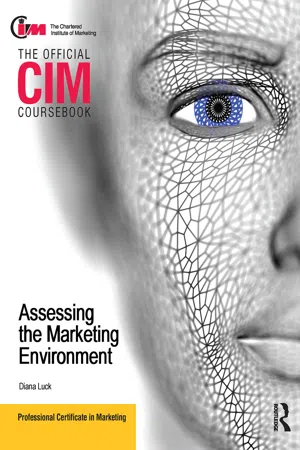
CIM Coursebook Assessing the Marketing Environment
Diana Luck
- 232 pages
- English
- ePUB (mobile friendly)
- Available on iOS & Android
CIM Coursebook Assessing the Marketing Environment
Diana Luck
About This Book
'Butterworth-Heinemann's CIM Coursebooks have been designed to match the syllabus and learning outcomes of our new qualifications and should be useful aids in helping students understand the complexities of marketing. The discussion and practical application of theories and concepts, with relevant examples and case studies, should help readers make immediate use of their knowledge and skills gained from the qualifications.'
Professor Keith Fletcher, Director of Education, The Chartered Institute of Marketing 'Here in Dubai, we have used the Butterworth-Heinemann Coursebooks in their various forms since the very beginning and have found them most useful as a source of recommended reading material as well as examination preparation.'
Alun Epps, CIM Centre Co-ordinator, Dubai University College, United Arab Emirates Butterworth-Heinemann's official CIM Coursebooks are the definitive companions to the CIM professional marketing qualifications. The only study materials to be endorsed by The Chartered Institute of Marketing (CIM), all content is carefully structured to match the syllabus and is written in collaboration with the CIM faculty. Now in full colour and a new student friendly format, key information is easy to locate on each page. Each chapter is packed full of case studies, study tips and activities to test your learning and understanding as you go along. •The coursebooks are the only study guide reviewed and approved by CIM (The Chartered Institute of Marketing).
•Each book is crammed with a range of learning objectives, cases, questions, activities, definitions, study tips and summaries to support and test your understanding of the theory.
•Past examination papers and examiners' reports are available online to enable you to practise what has been learned and help prepare for the exam and pass first time.
•Extensive online materials support students and tutors at every stage. Based on an understanding of student and tutor needs gained in extensive research, brand new online materials have been designed specifically for CIM students and created exclusively for Butterworth-Heinemann. Check out exam dates on the Online Calendar, see syllabus links for each course, and access extra mini case studies to cement your understanding. Explore marketingonline.co.uk and access online versions of the coursebooks and further reading from Elsevier and Butterworth-Heinemann. INTERACTIVE, FLEXIBLE, ACCESSIBLE
ANY TIME, ANY PLACE
www.marketingonline.co.uk
Frequently asked questions
CHAPTER 1
The Importance of the Marketing Environment
Learning Outcomes





THE IMPORTANCE OF THE MARKETING ENVIRONMENT


DEFINING ORGANISATIONS





BUSINESS CLASSIFICATIONS









